You've Got V-Mail
#164: Communication, Utriculi, Buklog, Mail Art, Paulo Bruscky, On Kawara, Leny Strobel/Hilary Giovale,Trinidad Escobar, Nairud sa Waba, Nala Sinephro, Florante Aguilar, Andy Thorne.
THEN & NOW
My focus on the Letter Project over the last year has got me thinking about past modes of communication and how we communicate nowadays.
Considering that most of my parents’ missives to each other traveled by ship or airplane, it’s amazing to me that they sent these out on a monthly basis during the 1940s, sometimes two or three times a month.
I learned that Naval personnel mail was microfilmed beginning in 1941 in order to reduce the volume of shipping space the letters took up. They competed with space for ammunition, food, and fuel. During WWII this mail was shipped and delivered as “V-Mail.” “V“ meaning “Victory,“ of course.
V-Mail was discontinued before the end of the war, so I don’t think there are any in my collection. Instead, there are the ubiquitous radio-transmitted RCA “Radiograms,” like the one my father sent to Mom regarding Philippine independence from U.S. colonial rule:
July 4 was originally chosen by the U.S. for the Philippines’ independence (which in my opinion seemed to suggest an ongoing dependence relationship), but in the 1960s the date was changed to June 12.1
Letter writing requires a certain physical commitment: the paper, pen, and ink; the handwriting, the purchase of envelopes and stamps, and most of all the patience to write your thoughts out on paper and then wait weeks for a reply. I notice that there are few, if any, crossed out phrases in their letters; they just left the grammar errors intact. I can rarely write a note without crossing a word out.
Now that electronic messaging has become so easy, we can communicate our thoughts and feelings through a mobile phone or computer. Behind the scenes, there is still a physical and material commitment in the form of energy sources such as electricity and water that we utilize. We are just not aware of it until the resource is removed.
But more than electronic messaging, we now have artificial intelligence (AI) in the form of ChatGPT, among others, to “aid” us in our communication. If our love letters need to be more persuasive, perhaps ChatGPT can be harnessed to move someone’s soul.
I’m not convinced.
In the last issue, “Time Travel,” I mentioned that my father, Nick, had been visiting Manila soon after its liberation. He met my future uncle Vicente, who invited Nick over to the family house, where he met my mother, Trinidad. I’d always wondered what happened when he met the family.
The earliest letter I could find while writing “Time Travel” was from August 20, 1945.
However, today I found two earlier letters; the first was dated July 3, 1945 from Trinidad to Nick. Whenever I find a new letter, I revise the timeline and what I thought I knew about their story. Trinidad begins her letter formally, but her writing soon becomes more casual:
Dear Mr. Vengua,
I cannot express my gratitude upon receiving the souvenir . . . I considered the souvenir you sent me as a greeting ‘cause it arrived exactly during my birthday and [it was] the first greeting in the morning of June 9 . . . Some of my birthday gifts were given by friends in the afternoon during the party, which was given by my mother in my honor. I never expect [sic] to be reminded of a far-away friend.
Nick, how is life going . . . anyway? When are you coming back to the Philippines? Soon . . . I hope.
What was the souvenir? I imagine it was probably an item from one of his trips—perhaps from Korea, San Francisco, or Hong Kong. Do I have it somewhere? Is it tucked away in my mom’s jewelry box?
The second letter, written on U.S. Army stationery, is from Nick dated July 29, 1945. I haven’t found the envelope. He discusses his rather boring shipboard routine: periods of hard work alternating with nothing to do, “just marking time until something new comes up . . . It’s just like a roulette game, ‘round and ‘round, where she stop[s] nobody knows. But no matter where we go from here on I expect to see you again soon.”
He has already agreed to help the family out by picking up some items for them, probably from the U.S., which he will deliver personally the next time he’s in Manila.
By the way how is the rain situation out there? You know I really couldn’t help but feel as if I was a jinx. Every time I came to see you it never failed to rain.
I have really enjoyed your hospitality, specially the food your mother cooked for us. I hope you will not tire [of] me for I really intend to come back, even if it would rain again ... Just imagine during that evening we had card games. Heard funny stories about Nelly’s talking aloud in the middle of her sleep, dreaming about someone. Dading [Trinidad’s sister] playing the piano, and listening to her lovely voice, and to Remy’s reading and interpreting of the cards. All these [things were] made possible because of the rain. So let it rain or shine. Mother nature couldn’t be stopped. Let [her] just take its course the way [she] likes, for under those dark clouds a poor man’s inspiration [is] born . . .
I’ve never met my maternal or paternal grandparents, so in reading this I wonder what my grandmother Matea cooked for her guests. Did my mom model her adobo after her mother’s? As a child, I have no youthful memories of extended family coming together like this. As an adult, I feel like I missed something, but as an only child my mostly solitary life seemed quite normal.
I found an envelope dated August 6, 1945—but no letter. I suppose it’s in one of the boxes, but I haven’t seen it yet. The date interests me because it would’ve been written just six days before Japan’s surrender to the U.S. was made public on August 14. The formal surrender would be on September 2, 1945.
I notice that the envelope has been stamped “Passed by Army Examiner,” which I assume is the censor. Later, in the 1950s, Dad would mention having to submit all his letters to a censor, especially during the period when he was working on ships involved in the Marshall Islands nuclear testing projects.
ART & WRITING
Hey, there’s nothing quite like seeing your art on the cover of two books! My ink drawing “Flow 2” is on the cover of the first issue of Utriculi, parts 1 and 2 (published by Sandy Press, edited by Harry K Stammer). I also have several more works published in Part 2; below are the soft cover volumes.
Speaking of “modes of communication,” I was very intrigued by Eileen Tabios’ prose piece entitled “The Courtship Phase Towards Technological Singularity,” which is also a conversation with a very affable ChatGPT responding to meditations on color in Tabios’ novel The Balikbayan Artist. That “politesse,” however, is not necessarily a sign that all is well, as Tabios suggests.
I was happy to see a number of familiar names among the artists and writers in Utriculi, people I know from my early internet days when I was just beginning to dive into the world of experimental poetry. Besides Eileen Tabios, these include Sheila Murphy, William Allegrezza, Mark Young, Tom Beckett, Harry K Stammer, and Thomas Fink. But there are many more contributors to the issue. Check it out!
The drawing I did below, Buklog 1, is one of four ink drawings (all 9.5 x 11 inches on Lokta paper) up at the Paraluman Art Show, Oct. 18, at Urban Arts Collaborative in Salinas Chinatown. Three of the ink drawings had been untitled since 2022, but I decided to name and number them Buklog 1, 2, and 3 because I wanted to experiment with the idea of art as a form of gratitude. “Buklog is a very complex gratitude ceremony performed by the Subanon (or Subanen) people of northeastern Mindanao. These are the tribal people from which my father’s family are descended.
It’s very interesting to create art with this shift in mindset and to think about it in terms of being grateful for being able to create art—for being an artist, for having materials such as paper, ink, pencils, etc., and for having a place in which to make art. This mind-shift (or perhaps heart-shift) feels like a relief. I’ll probably write more about this in a future issue of Eulipion Outpost.
RABBIT HOLE
Vanessa Davidson in conversation with Florencia Bazzano about radical mail art in Latin America as an exercise of freedom:
Brazilian subversive artist Paulo Bruscky:
Japanese conceptual artist On Kawara’s postcards:
Leny Strobel on Becoming a Good Relative: Calling White Settlers Toward Truth, Healing, and Repair by Hilary Giovale.
Author Elsa Valmidiano pointed out a comic by Trinidad Escobar that would’ve gone really well with my last issue, Time Travel! So I thought I would post a link to it here. And while you are at it check out more of her work, her art and activism. Trinidad Escobar at the Radar Reading Series on her life as an adoptee as portrayed in Crushed:
SOUNDINGS
Nairud Sa Wabad (from Zamboanga) performs a cover of Philippine folk legend Joey Ayala’s “Tabi Po” (“excuse me”). The song is about a person making a difficult hike up a rocky mountain and encountering a mischievous mountain engkanto (sprite) who steals his shoe. Angry, he’s forced to spend the night, but ends up becoming enchanted by the stars and the mountain animals and insects around him. His shoe mysteriously appears again in the morning. I enjoy the group’s animated performance, including their improvised animal noises:
Composer Nala Sinephro is Subverting Jazz (article in Pitchfork). And here is her album, Endlessness:
Manila Galleon Guitar Music by Florante Aguilar, which I wish I had included in my “Bloody Mutiny/Public Folly” issue, but better late than never?
There are many modes of communication. Andy Thorn plays “Aesop Mountain” (from his album Songs of the Sunrise Fox) for an appreciative wild fox—or is it a mischievous engkanto?:
Big thanks to all of you who read Eulipion Outpost regularly, and to those who have subscribed here or donated on my Ko-fi page to support my efforts.
My ongoing appreciation goes to the Mysterious M. for his editing.
Website and blog: Jeanvengua1.wordpress.com
Links List on a just-for-fun, old-school Neocities site that I built.
Eulipion Outpost is a reader-supported publication. To receive new posts and support my work, consider becoming a free or paid subscriber.
They did retain July 4 for “Philippine Republic Day.”

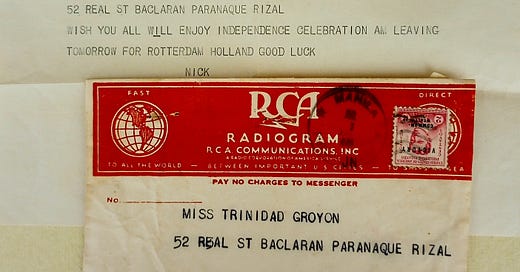



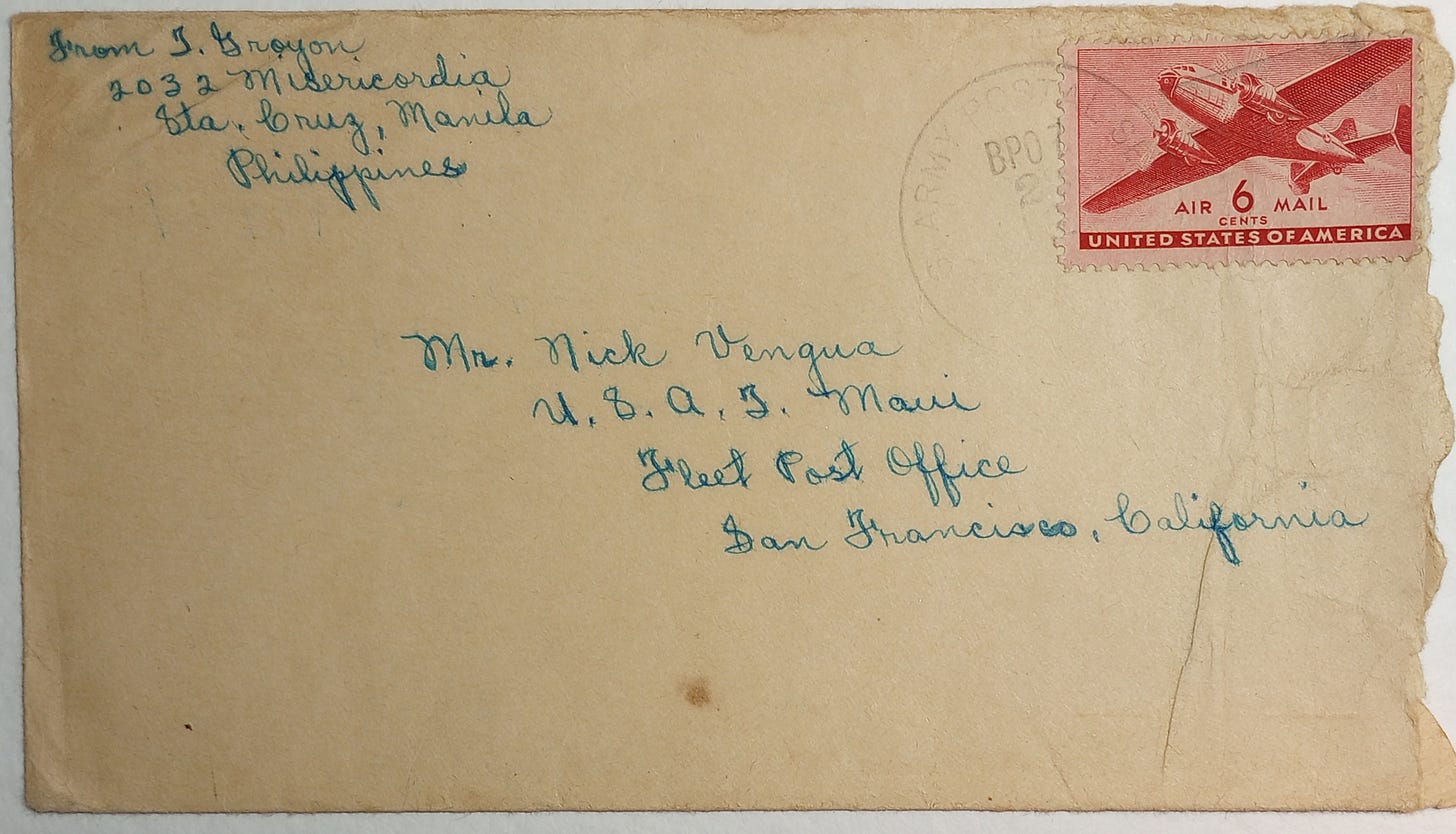
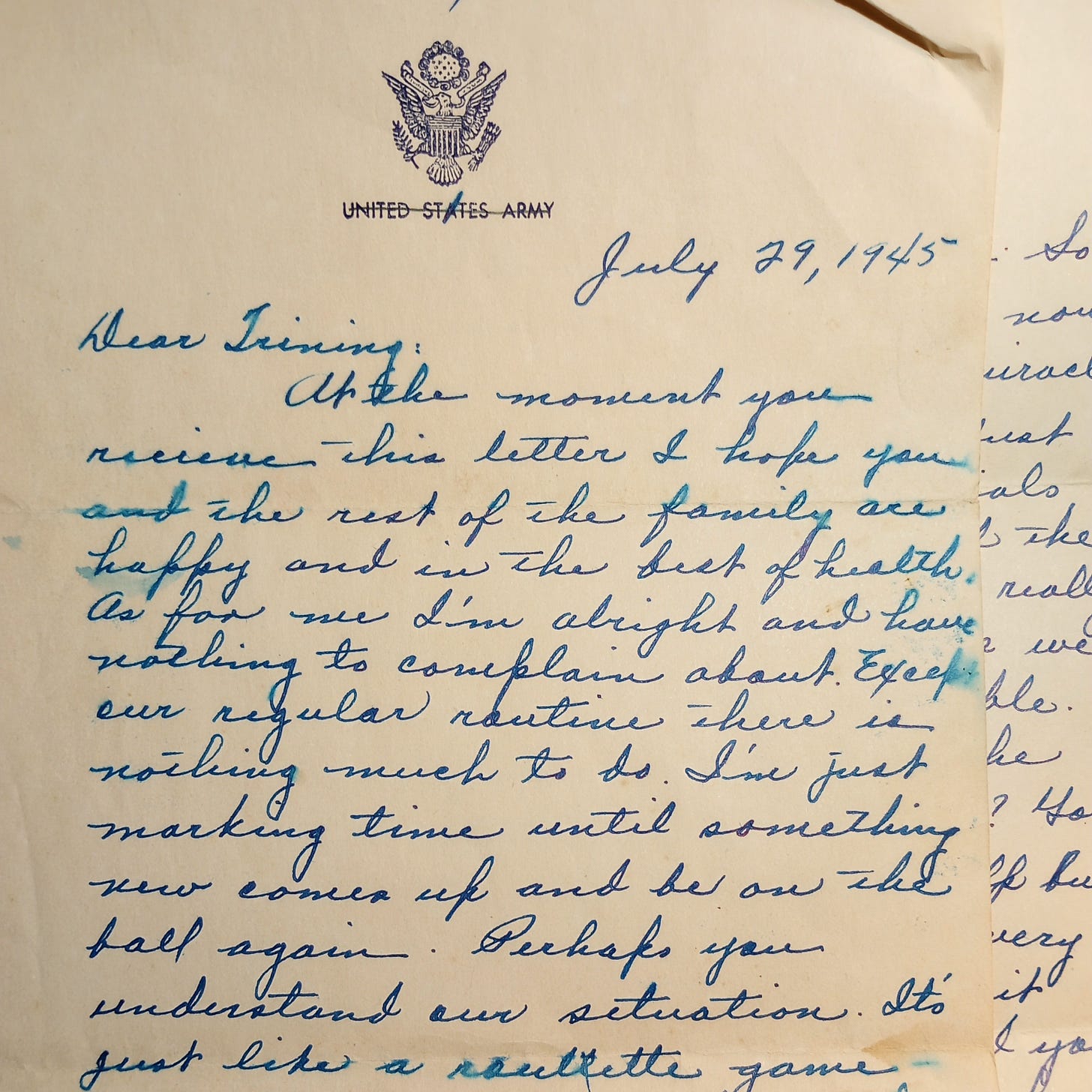
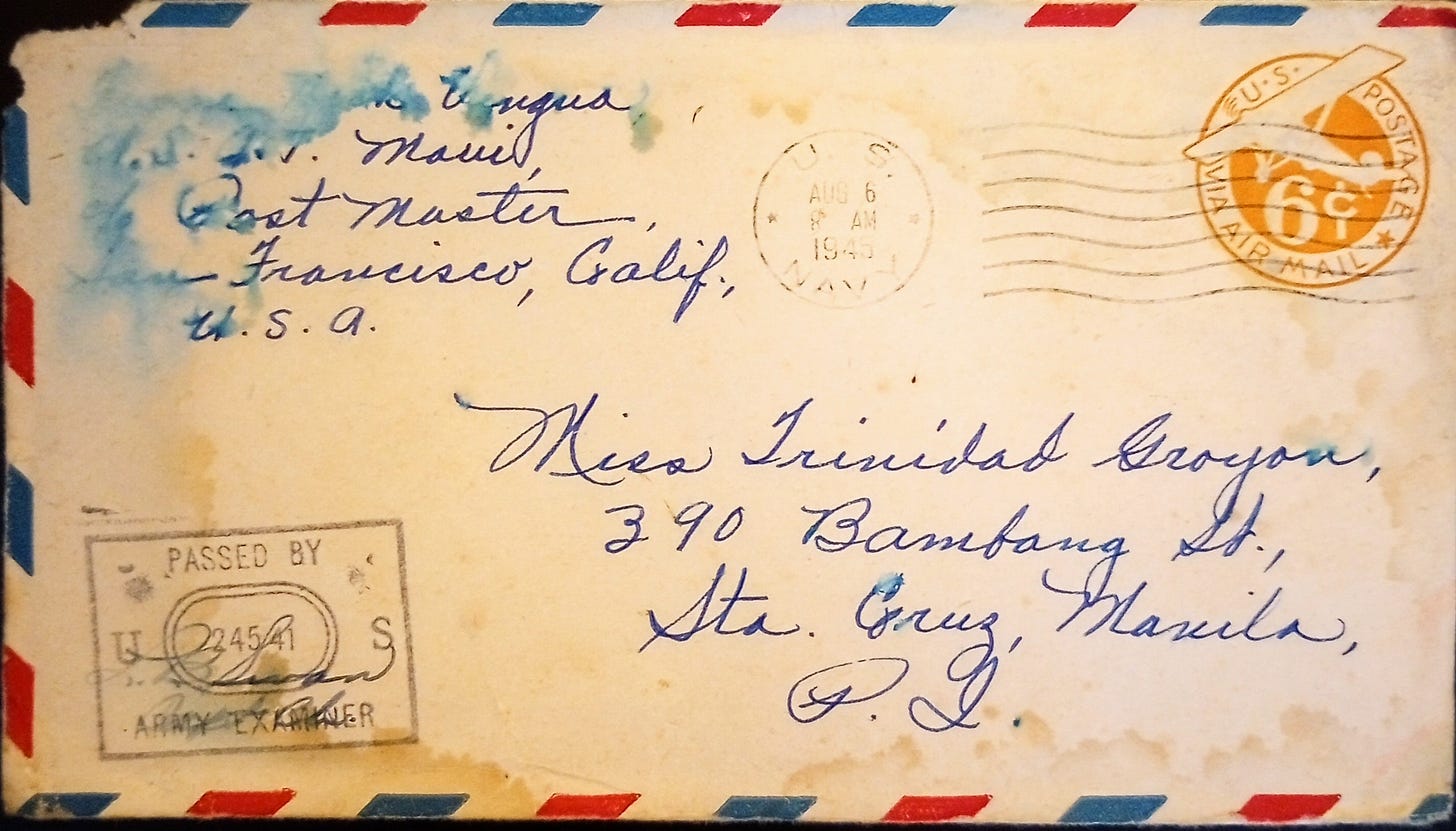
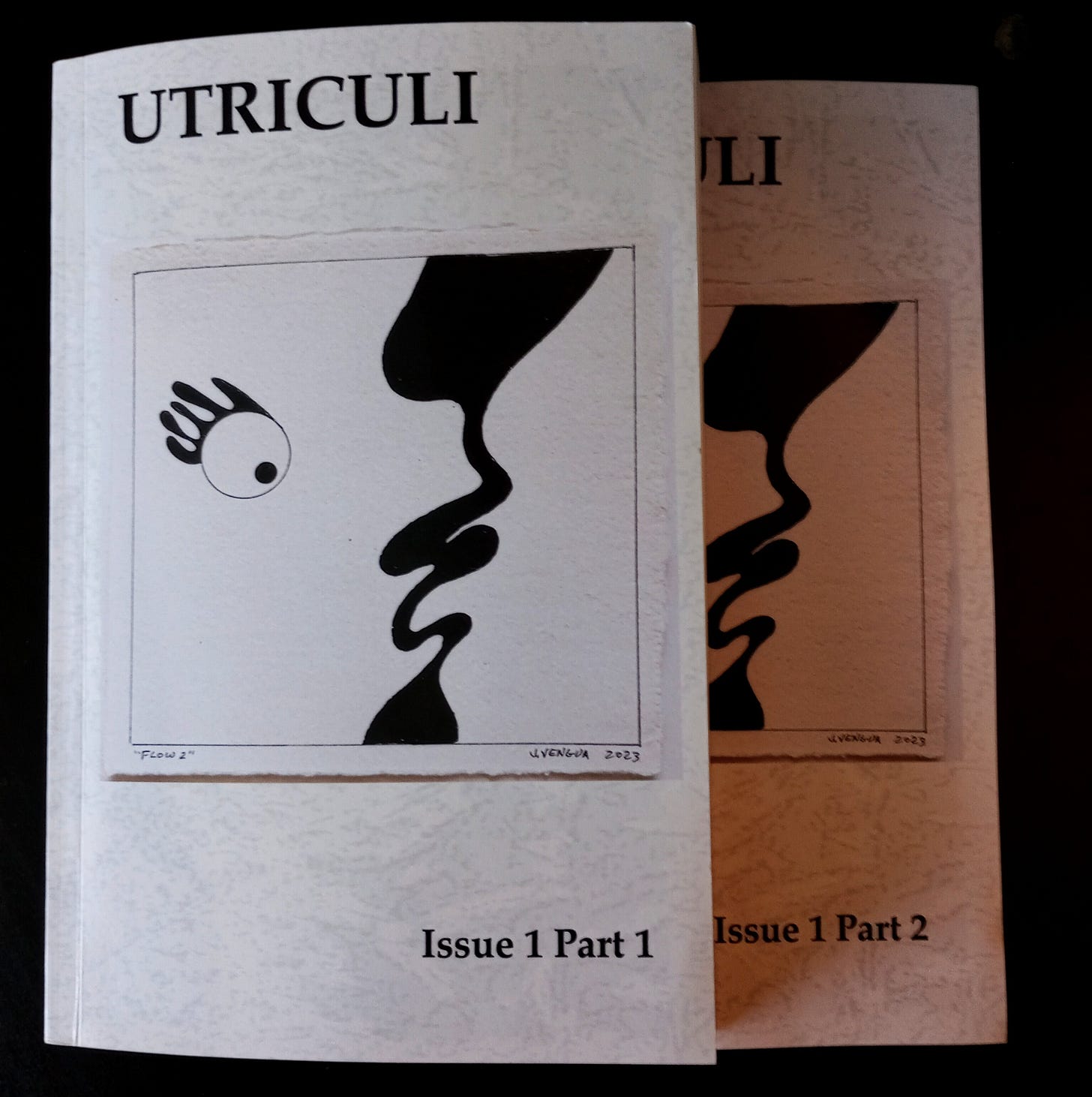

Your family letters are beautiful, thank you for sharing them. After my grandparents died in the 2000s, I found a large bag of letters. They were between my grandparents as my grandfather moved from parts of the Philippines to Germany, and then USA. I went through them similarly as you've done here. Thank you again. - Trinidad
Beautiful rumination on letters and on how your parents communicated in those years. Some of my last letter exchanges were with my father, who remained a regular letter-writer to many friends until his passing in 2011. Though we also spoke on the phone, the letters allowed him to relate something more immediate, and often more emotional. I love that you have this opportunity to recreate this timeline and that you are sharing this with us!